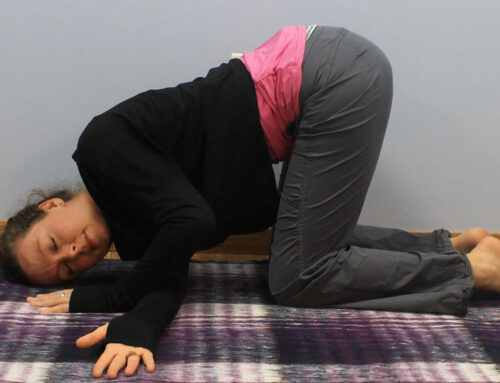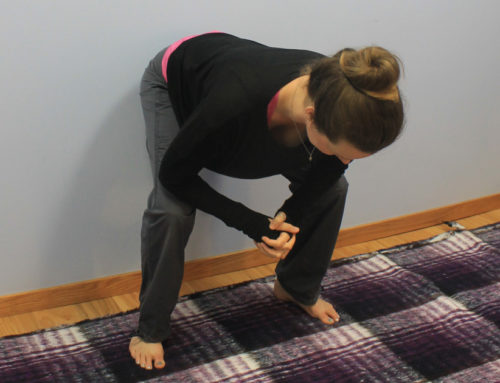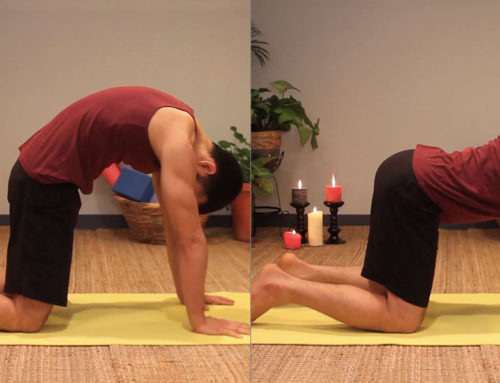Let’s imagine you have a meeting in five minutes and have lost your thumb drive with the presentation on it. You have two choices:
- calmly look for your drive, or
- let the fight-flight-freeze reaction hijack your nervous system.
The stress is there, but you can choose how to react to it.
Connecting with your breath
Connecting with the breath is a tool to help prevent the nervous system from jolting into sympathetic nervous system dominance (fight-flight-freeze). In this example above, it isn’t practical to take a seat and meditate—you don’t have that kind of time.
But you can still overcome the fight-flight-freeze impulse with the “letting go breath”—a quick reboot you can practice anywhere. As you search your office for the thumb drive:
- Inhale through your nose.
- Exhale out on a sigh.
- Repeat as often as you like.
The “letting-go breath” can be performed quietly but it can also be used to create a big sigh of tension out of the body. Notice if you inhale your arms overhead, that as you swoop your arms down and sigh, your rib cage softens.
Breathing, just like singing and chanting, is a powerful type of pranayama. Pranayama is one of Patanjali’s limbs of yoga that we can practice all day off the mat.
We can’t change many stressors in our lives, but we can learn to control our reactions to them. The more we shift our attention to mindful breathing, the easier it becomes.
I recommend clients set a timer on their phone to go off every 20–30 minutes to remind them to look up from the computer, inhale the shoulders up and exhale the shoulders back down on a sigh.
This is one of many examples of how pranayama can decrease stress in the physical body and refresh the mind. I learned this pranayama from the lovely Sudha Lundeen at her Restorative Yoga workshop at Kripalu many moons ago and use it on a daily basis both for myself and clients. Enjoy!
Photo: Dandelion Wish by John Liu via Flickr, used under Creative Commons 2.0







[…] Iyengar describes pranayama as “extension of breath and its control”. Pranayama can be practiced alone or in coordination with asana. Mindful pranayama encourages the student to explore diaphragmatic breathing without gripping and holding tension in the chest and ribcage. To learn more about the relationship of the breath and the pelvic floor, check out this video blog. If you wish to gain knowledge about different types of pranayama, read my blogs about dirga, ujjayi and letting go breath. […]
[…] Iyengar describes pranayama as “extension of breath and its control”. Pranayama can be practiced alone or in coordination with asana. Mindful pranayama encourages the student to explore diaphragmatic breathing without gripping and holding tension in the chest and ribcage. To learn more about the relationship of the breath and the pelvic floor, check out this video blog. If you wish to gain knowledge about different types of pranayama, read my blogs about dirga, ujjayi and letting go breath. […]
[…] also like using the “letting go breath” in this posture. This is a quick reboot to the you can practice […]
[…] To learn more about the relationship of the breath and the pelvic floor, check out this video of pelvic floor movement with the breath. If you wish to gain knowledge about different types of pranayama, read my blogs about dirga, ujjayi and letting go breath. […]
[…] letting go breath […]
[…] To learn more about the relationship of the breath and the pelvic floor, check out this video of pelvic floor movement with the breath. If you wish to gain knowledge about different types of pranayama, read my blogs about dirga, ujjayi and letting go breath. […]
[…] Read more about the Letting Go Breath. […]
[…] quiet grounding. Taking a pause in this posture, especially when paired with paced breathing or the Letting Go Breath, calms the sympathetic nervous […]